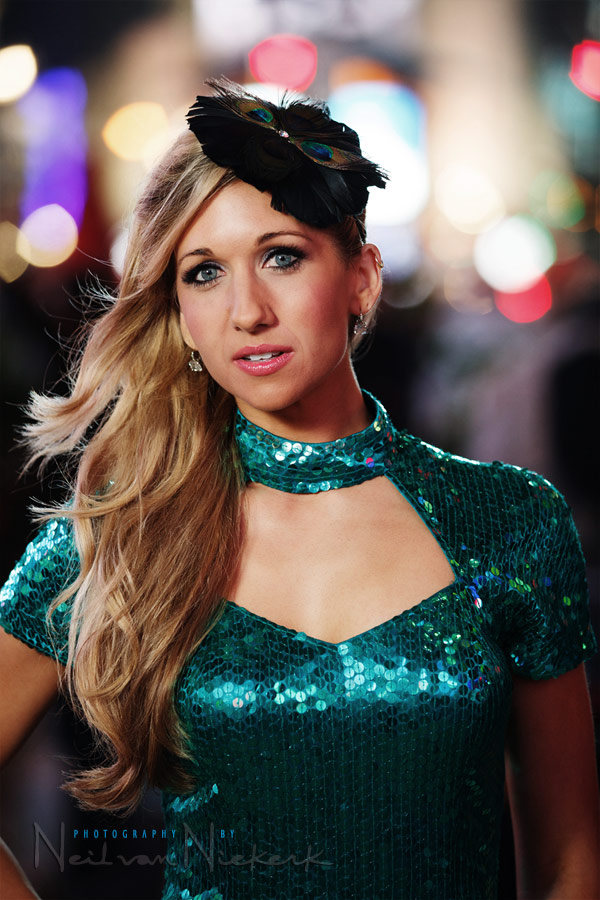
Photo session with a model in New York
I have already showed part of the photo session with Sarah Raley, in the article, vintage photo session w/ off-camera flash. It was part of a longer on-location photo session in New York. With four changes of clothing, we aimed for a diverse look during the photo session. I’d like to share some of them here, along with some of the lighting techniques, and post-processing.
Most of the photos were taken with the Canon 5D mark II, and two zooms:
the Canon 24-70mm f/2.8L II (affiliate), and the Canon EF 70-200mm f/2.8L IS II (affiliate).
The lighting in nearly all images were with a Canon 600EX-RT Speedlite (affiliate), in a Lastolite EZYBOX 24×24″ softbox (affiliate), held up on a monopod by my assistant for the day. I controlled the Canon 600EX-RT with the Canon ST-E3 Speedlite Transmitter (affiliate) on my camera. The built-in radio capability of the superb Canon 600EX-RT Speedlite (affiliate), really made it all so much easier. Check out my review of the Canon Speedlite 600EX-RT.
With the 15 main images selected to show here, I wanted to show some of the thought-process during the shoot, as well as the influence post-processing has on the final result.

- camera settings: 1/125 @ f/3.2 @ 800 ISO … TTL flash
- Canon 5D mark II / Canon EF 70-200mm f/2.8L IS II
- Canon 600EX-RT Speedlite / Canon ST-E3 Speedlite Transmitter
- Lastolite EZYBOX 24×24″ softbox
I didn’t need a back-light here, since the photo was taken in Times Square, and the place is usually awash with light. So it was a matter of finding an out-of-focus background that was complimentary to the glitzy evening dress. Doing portraits down in the crowd, there were a lot of people milling around. Wide apertures, shooting a lot, and being purposeful about my composition, gave me clean backgrounds in the images I chose from this part of the session.
The post-processing was as described in the article on Photoshop tips – retouching for portraits. However, the image’s saturation was too much, so I changed the look of the image further with a Gradient Map Adjustment layer in Photoshop. A further adjustment layer to pull down the Saturation helped too.
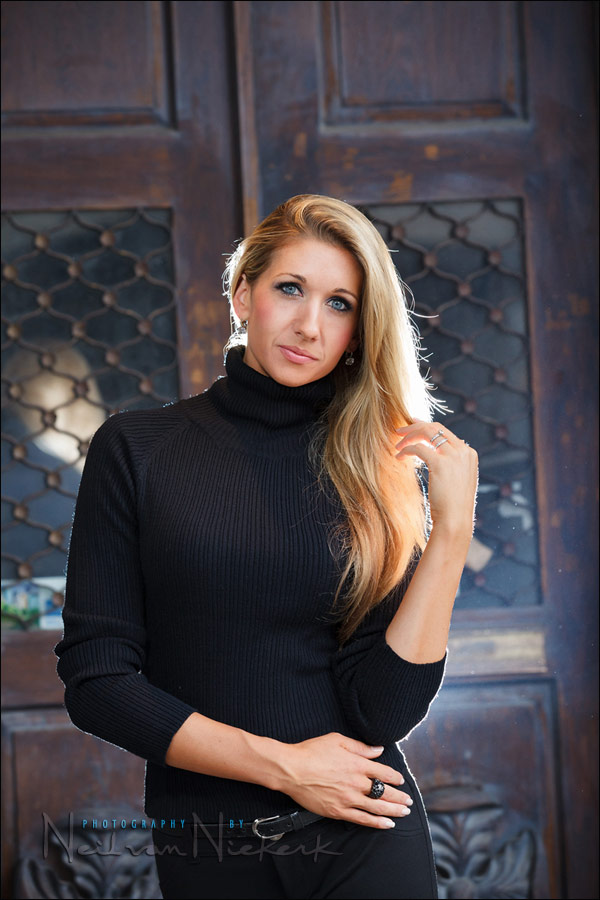
- camera settings: 1/200 @ f/5.6 @ 800 ISO
- manual flash behind; main light with softobox
- Canon 5D mark II / Canon EF 70-200mm f/2.8L IS II
- Canon 600EX-RT Speedlite / Canon ST-E3 Speedlite Transmitter
- Lastolite EZYBOX 24×24″ softbox
A photo from the start of the session – still trying to find a rhythm. As you can see, I over-did the backlighting a bit. (It was a flash on a light-stand behind Sarah.)

- camera settings: 1/200 @ f/4 @ 100 ISO … TTL flash with softbox
- Canon 5D mark II / Canon EF 70-200mm f/2.8L IS II
- Canon 600EX-RT Speedlite / Canon ST-E3 Speedlite Transmitter
- Lastolite EZYBOX 24×24″ softbox
Standing on a chair, to get an elevated view, I tried to eliminate distracting background elements such as cars and buildings. I wanted the receding repetitive pattern of the brick-road as a background. But with this one image, someone walked by with a dog … and for me, the B&W image just works. The black outfit also worked with the monochrome treatment.

- camera settings: 1/200 @ f/4 @ 100 ISO … TTL flash with a softbox
- Canon 5D mark II / Canon EF 70-200mm f/2.8L IS II
- Canon 600EX-RT Speedlite / Canon ST-E3 Speedlite Transmitter
- Lastolite EZYBOX 24×24″ softbox
The boldly colorful opposite of the B&W image above.
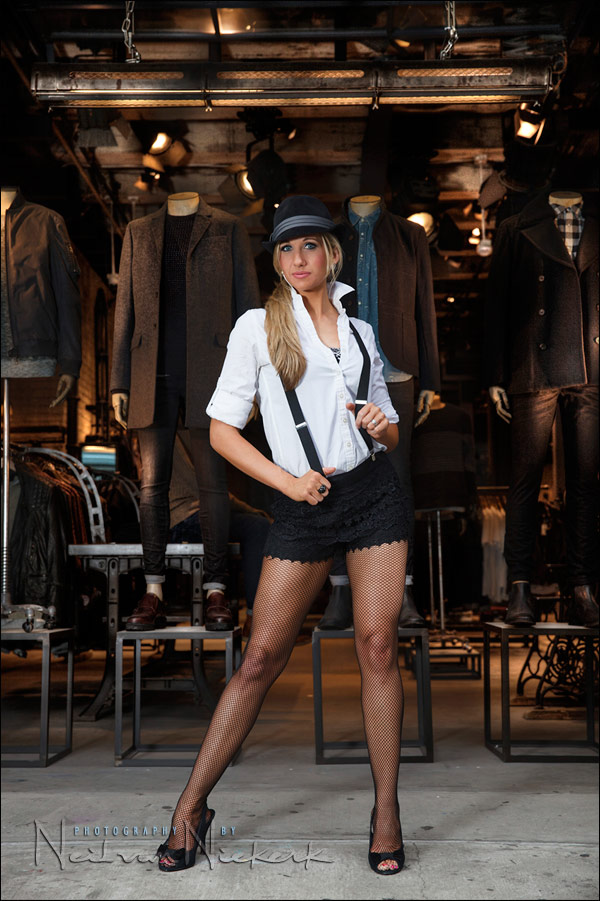
- camera settings: 1/200 @ f/4.5 @ 400 ISO … manual flash
- Canon 5D mark II / Canon 24-70mm f/2.8L II
- Canon 600EX-RT Speedlite / Canon ST-E3 Speedlite Transmitter
- Lastolite EZYBOX 24×24″ softbox
With this image, I changed the post-processing up a bit. The basic start to most of my portrait retouching, is the use of two Photoshop filters – Shine Off and Portraiture. This is described in detail in the article, Photoshop tips – retouching for portraits. That version is shown below.
The final image (shown above), had another layer added to it though. This additional layer was selectively brushed in for parts of the background, as a Soft-Light layer. What makes it different is that it was a tone-mapped version (done via Photomatix). This brought in a semi-HDR effect on parts of the background.
The straight version:

The test shot without flash:

The pull-back shot to show the position of the light. I had to instruct my assistant to hold the softbox noticeably lower than I normally would, because I needed to get some light in under the brim of Sarah’s hat.
 ]
]
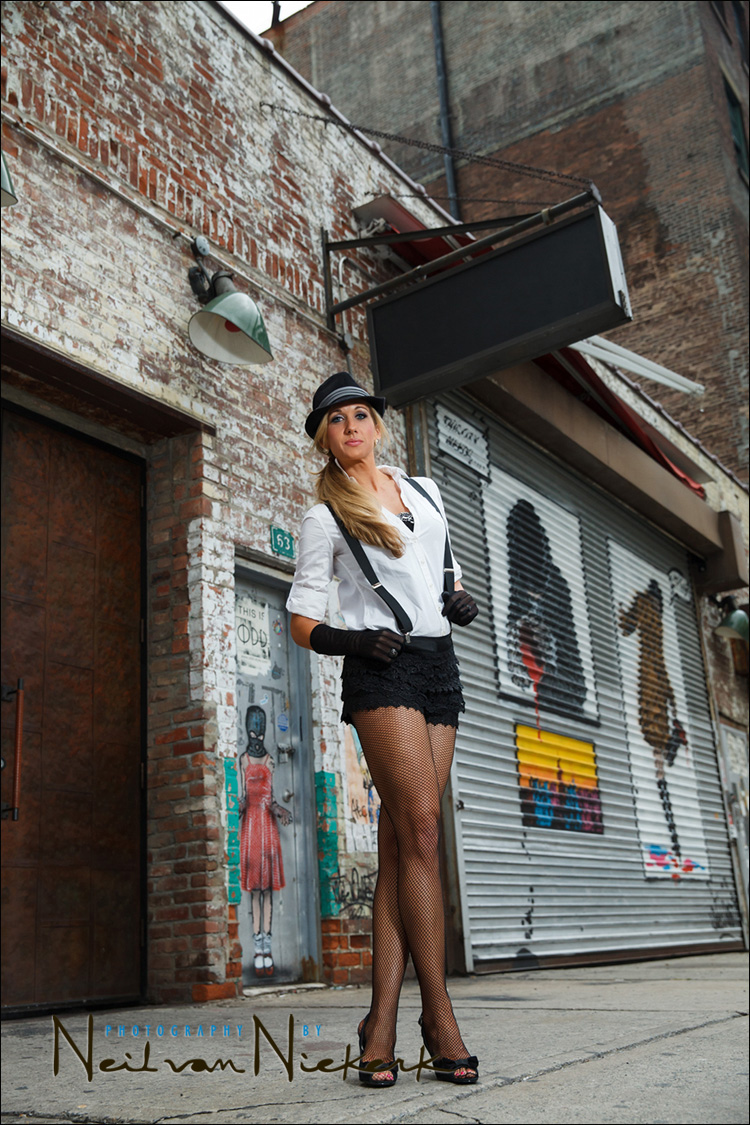
- camera settings: 1/160 @ f/4 @ 800 ISO … manual flash
- Canon 5D mark II / Canon 24-70mm f/2.8L II
- Canon 600EX-RT Speedlite / Canon ST-E3 Speedlite Transmitter
- Lastolite EZYBOX 24×24″ softbox
This set of images had camera settings which differ slightly. This is because the light was changing, with clouds coming in, and then opening up slightly again. Keep in mind here that with these images, the flash isn’t lighting up the entire scene. Just my subject. So this really is an exercise in balancing flash with available light. The simplest approach is to under-expose the ambient light on my subject somewhat. Around -0.7 EV or 1 EV. And then add TTL flash to clean up the light on her.
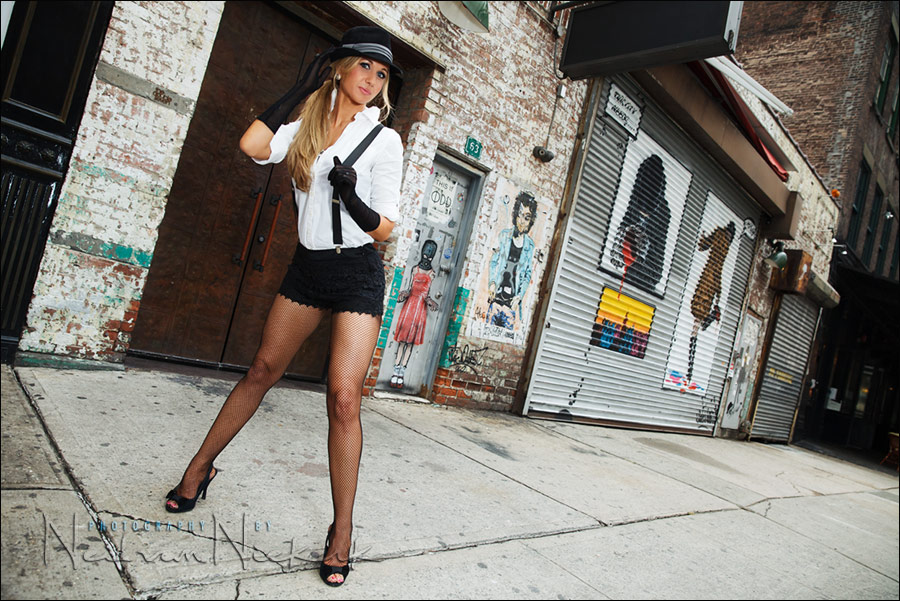
camera settings: 1/125 @ f/4 @ 800 ISO … manual flash
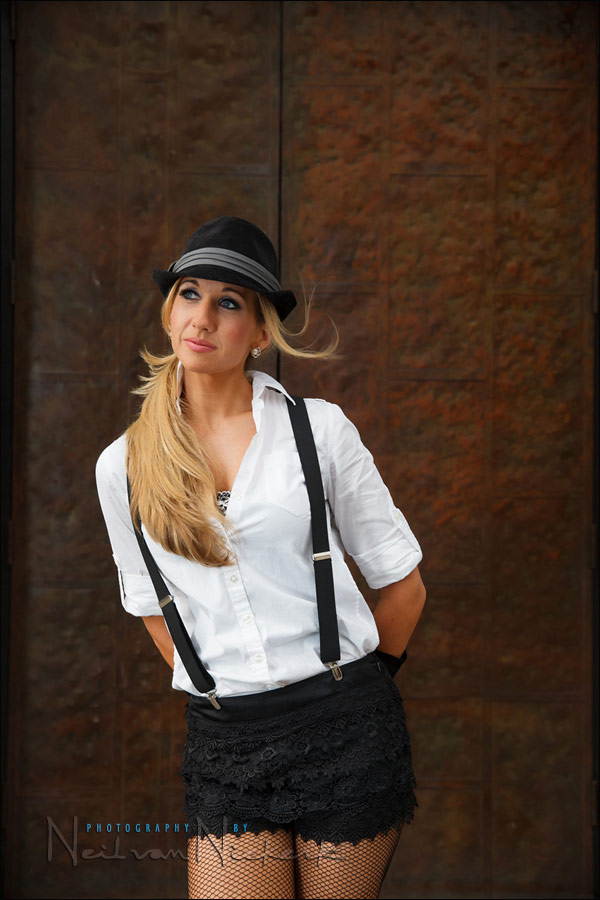
camera settings: 1/200 @ f/4 @ 800 ISO … manual flash
These two images are amongst my favorite images during this shoot. It shows Sarah’s personality. I also love the background here – a doorway.


camera settings: 1/200 @ f/5.6 @ 400 ISO … manual flash
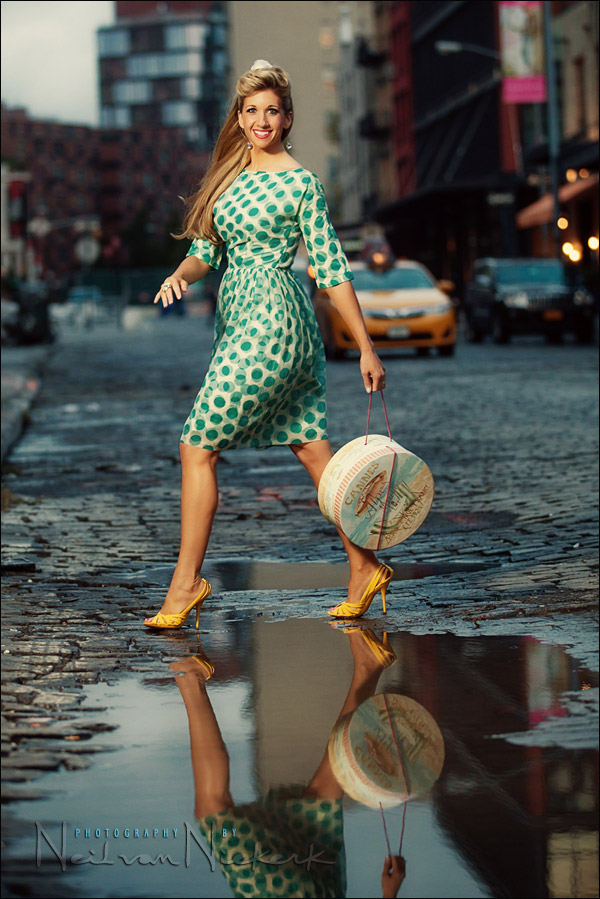
For this part of the photo shoot, Sarah wore this vintage dress and had a hatbox which she carried.
camera settings: 1/200 @ f/2.8 @ 640 ISO … manual off-camera flash
The details for this image is described in the separate article, vintage photo session w/ Sarah, including the camera and flash settings.
This, and the other images in this set, were enhanced with a Photoshop plugin to give a warm Vintage feel to the photograph. I changed the post-processing between these images, so they all have a slightly different look. Normally, I would aim for a consistent look and feel to the images, and keep the post-processing the same.

camera settings: 1/200 @ f/4 @ 800 ISO … manual off-camera flash
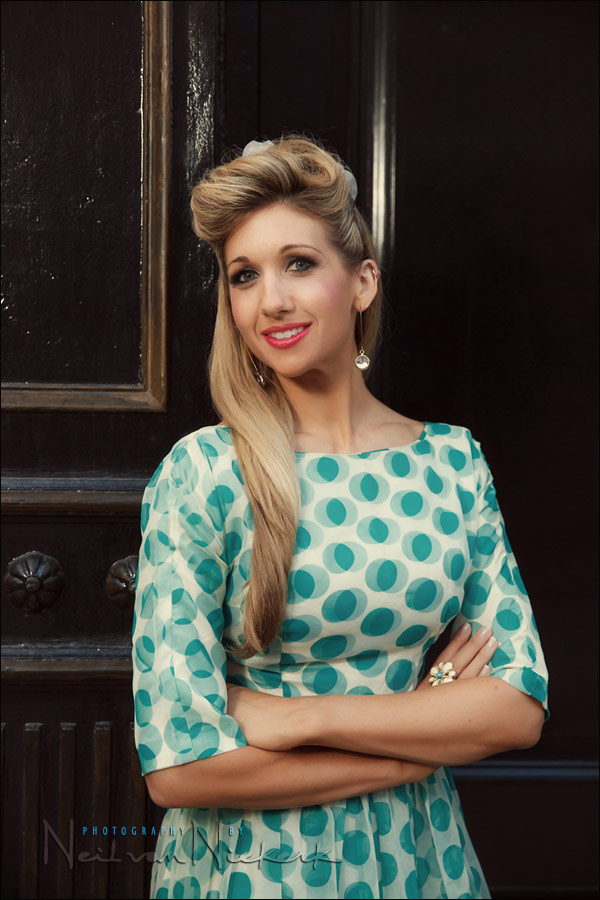

camera settings: 1/40 @ f/3.2 @ 800 ISO … manual off-camera flash
By now it had turned considerably darker, so I dropped my shutter speed. I also opened my aperture (and adjusted my flash output accordingly.)
Here is the straight image as comparison.


camera settings: 1/20 @ f/4 @ 800 ISO … manual off-camera flash
Even darker still, I dropped the shutter speed even more to bring in the available light. In the full-rez image, you can see some blur around the edges of her, where the ambient light smeared against the slightly brighter sky. But since my subject was in darkness, the flash was able to freeze camera movement in general. It’s just that it still shows up against a brighter background.
The question as to whether flash freezes action and movement, always has a complex answer … it depends. We’ll come back to this topic over time.
As you can see in the image above, there is dramatic light fall-off to the bottom of the image. This was purposely done. I asked my assistant to point the softbox upward, so that Sarah was lit only by the edge of the cone of light emanating from the softbox.
The pull-back shot, and the two comparison images so the light fall-off can be seen, compared to a more straightforward shot. As you can see, the unattractive gravel paving is too prominent in the “well-lit” shot.



Finally, Times Square! The image at the start of this article, was taken during this later part of the photo session. For a last few photos of Sarah, was shot with the Nikon D4 (affiliate), and Nikon 24-120mm f/4 VR (affiliate) lens. For this sequence, I relied on the flood of available light in Times Square.

- camera settings: 1/30 @ f/4 @ 1250 ISO … available light, hand-held
- Nikon D4, and Nikon 24-120mm f/4 VR @ 24mm
Related articles:
- Other photo sessions with Sarah R
- Flash photography tutorial
- So what are your camera settings?
- Off-camera flash photography
Hi Neil. Your 5dmkii and 600ex-rt seem to operate fine at the camera’s max sync of 1/200. The manual says this is not possible with the radio. Can you elaborate?
Tony, as I mentioned in my review of the Canon ST-E3, and my review of the Canon 600EX-RT speedlite, the flash was able to sync at 1/200
The pictures are fantastic, as usual!
I have an off-topic question: have you ever used sony camera gear? If so, how is it in relation to canon/nikon.
Just about every photographer I know uses canon or nikon. For many years I’ve been shooting on sony & their new cameras look so good. After both my old sony cameras(A850 & A200) were stolen, I purchased A77 which blew my mind with a lcd screen that flips(awesome to shoot wedding receptions!!!), to say nothing of the sony flashes that swivel in an absolutely fantastic way. I’m ready to buy A99 & 2 lenses(24-70, 2.8 & 70-200 2.8) & a flash so that I could have 2 complete sets for weddings in case one body fails, but I’m still in doubt whether I should get a different brand. I loved my a850 but who knows, maybe I just didn’t know any better? oh I’m in doubt… hahhahahaa Any advice?
I’ve shot with the Sony A-900 as part of an 85mm lens test, and during one maternity photo session. Nice enough camera, especially with the Sony 85mm f/1.4
However, the controls and AF are too slow compared to a camera like the Nikon D3 (that I used at the time). So the Sony wouldn’t be a camera that I’d easily adapt to for professional work.
I’ve only tried the new Sony A-99 at trade shows. Lovely camera – but the electronic viewfinder … I’m not a fan. I like optical.
the photos with the clothing store as the background are perfect!
Great post Neil. Very informative as usual. Have a great Christmas and festive greetings to you and your nearest and dearest.
Has your opinion of the new 24-70 2.8 changed after this shoot? Your review a couple of weeks ago left me grumpy for days!
Many thanks for another year of Tangents – THE best blog on the web!
All the best for Christmas and 2013 from sunny Nairobi, Kenya!
Pete .. the lens I used in these images, is the same lens that I had for the test. I just hand-picked the images which were sharp.
Thank you for the kind words! Please put the word out there.
Not a fan of jessica’s new look… LOL
Thanks for another great tutorial Neil. Fabulous photos.
I had a couple of questions:
-Doesn’t sound like you used any fill (either fill flash or reflectors). Is that so? And if not, why/how did you not need it? The light on her face is the nice wrap-around smooth ratio that is very pleasing, not a more split light look I would have expected with just one light on the side. Maybe the softbox was more toward center than I think? Maybe the balance with ambient achieved this?
-For your photo(s) with the gritty graffiti-filled background (hat and black shorts) what is the reason for underexposing the ambient light on your subject?
-This isn’t a question. I think the flash light behind the subject (black turtleneck, nice door) is not too much at all. Dramatic yes but I like it a lot.
I don’t use an an additional (3rd) light like that on location. It just becomes too much of a circus with the logistics. I like being able to move around.
So I do keep my softbox around 30 degrees to the side, at most … unless I direct the model’s gaze towards the light for more dramatic light.
I had to under-expose the ambient for my subject, since over-exposure would be a bad idea. ;)
Why I didn’t just expose correctly and add fill-flash at 2EV or there-abouts? Then I have less control over the way the photo looks.
By under-exposing somewhat for my subjects, they usually pop more … compared to just a hint of fill-flash.
“The question as to whether flash freezes action and movement, always has a complex answer … it depends. We’ll come back to this topic over time.”
I’m very much interested in this topic, it’s something I need to learn and have become frustrated with. I’m so looking forward to your discussion on this, because like you said… it can be complex, and I’m just not getting it.
As for these photos, I love love love the ones of her with the men’s clothing store as the background! Thank you so much for all the great information. And by the way, Sarah is gorgeous! Any hair tips? :-)
Neil,
Well, I guess I’m a slow learner. It seems everytime I think I understand things, I then go out and try and wonder where I went wrong! :-( I went out last night with the sole purpose of shooting a model at night.
Using my D700, SB-910, PocketWizards TT1 on camera, TT5 on flash inside an Impact 28″x28″ softbox. Now, I live in a small town so our city lights would never compete in brilliance with Times Square and I’m wondering if light levels is part of my issue. Meaning, do my background light levels have to be in the range of 1/125, f4, ISO 1600 (or less) so TTL isn’t shocked. My settings were more like 1/80, 3.5, ISO 2500. I just notice in most of your night images, there are brilliant and colorful lights behind. Seems to balance model and background much better than I had for what I was doing.
I tried to shoot in TTL but after setting my ambient lights for my background, I turned on the flash and practically vaporized my model. I took several more shots dialing my FEC all the way to -3. Once there, it was almost managable but still too hot in my opinion. Also, it looked like dreaded flash. Should I have gelled?
Anyway, I took it off TTL and went to Manual. I didn’t bring my light meter so I just did it by eye. Some shots came out nice but I can’t figure out how to make my image bright and balanced.
Your book is on the way to my house. I’m hopeful I’ll understand this soon.
David
David … one of my first considerations with on-location portraits, is the background.
For low-light photos such as in the evening, I will purposely seek areas where there is some color or detail in the background that will prevent the photo from having just a black detail-less background.
So that is important. As I have mentioned before, I pick my battles when it comes to on-location lighting. I don’t try to make everything work.
Re TTL vs Manual flash in this situation – I would strongly suggest manual flash. With so much of your scene in darkness, the TTL flash will have a tendency to over-expose. Even when you do nail the exposure by dialing the FEC In correctly on a guesstimate, the moment you change your composition, your TTL exposure will vary again.
Best of luck with the next attempt!
Great pictures Neil, I have the 5D III and 600 EX RT speedlight which are great, but here is the thing, I know off camera flash but with Nikon in off flash manual mode it gives you a flash to subject distance which Canon does not and the only way I was able to get the flash to subject distance on Canon was to purchase the Pixel Kings that works great that way I know if my flash to subject distance is say 10ft and I am using an umbrella I know that instead of 10ft I need to move the flash to like 5ft or open my aperture to make up for the loss of light, but I want the ST-E3 but from what I have read is it does not give you a flash to subject distance in Manual mode, what is the work around for this instead of figuring it out that can take some time? thanks and also happy new year;)
Knowing the subject-to-flash distance is only useful if you use bare flash. Then, even though the Canon flashes don’t show the distance scale immediately, there is a work-around. Put the flash on your camera to see the distance.
– getting the most out of your flash / speedlite / speedlight
– tutorial: how to use the guide number of your flash
Mostly though, when using manual flash with a softbox on location, I just look at the LCD previews.
Hi Neil
I’m a long time admirer of your work and thanks for another very informative post.
I am about to spring for an Ezybox. I see they do a Joe McNally version which has an all white interior and claims to give a smoother more gentle light. Have you any experience with this or views as to whether this is the better option.
Also, lastolite offer a grid to direct/control the light better. I can’t recall having seen a post where you’ve used this modifier, again, do you feel this necessary to control the light a little better.
The only downside with either of these options I can see is that they might suck a little power. What do you think?
I would use it mainly for location portraiture.
Thanks.
Neil
I can’t help you with this one, sorry. I haven’t tried (or compared) the McNally version of this softbox.
Thanks Neil;)
Wonderful photos!